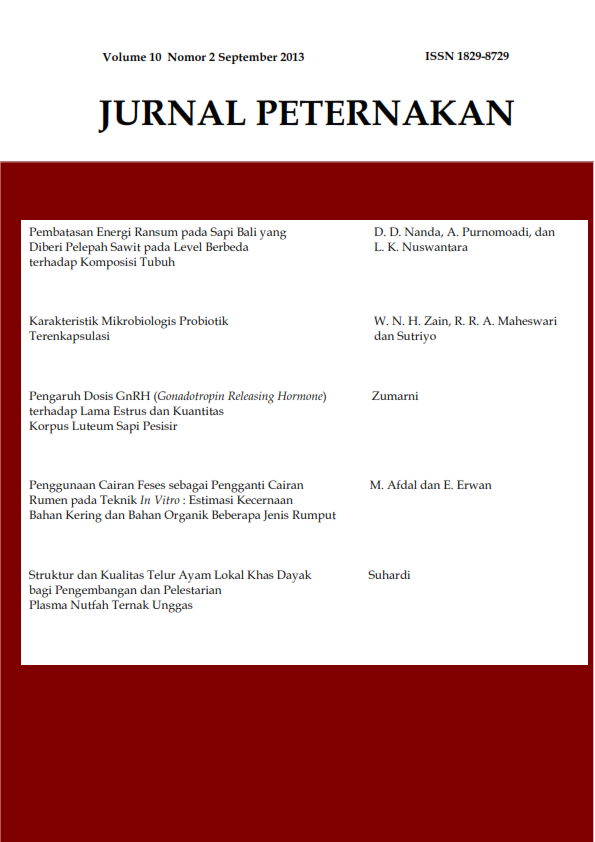PEMBATASAN ENERGI RANSUM PADA SAPI BALI YANG DIBERI PELEPAH SAWIT PADA LEVEL BERBEDA TERHADAP KOMPOSISI TUBUH
DOI:
https://doi.org/10.24014/jupet.v10i2.2310Keywords:
Bali cattle, body composition, palm frondAbstract
Nowadays the livestock industries are required to produce a low-fat meat, because fat has a negative effect on the health
of consumers. Efforts to address the accumulation of fat is done by energy restriction in animal feed. If the feed does not meet
the needs of energy, then these requirements will be met by dismantling the body fat stores. Feed given to cows intended to
produce maximum production performance. The productivity of an animal to be seen apart from the weight gain, it can also
be reflected by the composition of body components. One way to look at the composition of the animal body components with
urea space techniques. The aim of this research was to determine the potency of palm frond as a grass field alternative to bali
cattle diet. The experimental design used was a randomized complete block design consisted of 4 treatments and 4
replications. Feed treatments were : A = 60% field grass + 40% palm cake, B = 40% field grass and 20% palm frond + 40%
palm cake, C = 20% field grass and 40% palm frond + 40% palm cake, D = 60% palm frond + 40% palm cake. The results
showed that the use of palm frond various levels did not significantly (P>0,05) affect the value of the body composition.
Average water body on treatment A, B, C and D were 51.15%, 51.24%, 50.61% and 50.85%, respectively. An average body
protein on treatment A, B, C and D were 13.22%, 13.23%; 13.0% and 13.15%, respectively. Average body fat in treatment
A, B, C and D were 30.49 %, 30.37 , 31.19 and 30.88 %, respectively. This study demonstrated that administration palm
frond could be used as grass field alternative to cattle diet.
Downloads
Published
Issue
Section
License
The Authors submitting a manuscript do so on the understanding that if accepted for publication, copyright of the article shall be assigned to Jurnal Peternakan and published by Fakultas Pertanian dan Peternakan Universitas Islam Negeri Sultan Syarif Kasim Riau as publisher of the journal.
Authors who publish with this journal agree to the following terms:
Authors automatically transfer the copyright to the journal and grant the journal right of first publication with the work simultaneously licensed under a Creative Commons (CC BY) that allows others to share the work with an acknowledgement of the work's authorship and initial publication in this journal.
Authors are able to enter into separate permission for non-exclusive distribution of the journal's published version of the work (e.g., post it to an institutional repository or publish it in a book), with an acknowledgement of its initial publication in this journal.
Authors are permitted and encouraged to post their work online (e.g., in institutional repositories or on their website) prior to and during the submission process, as it can lead to productive exchanges, as well as earlier and greater citation of published work (See The Effect of Open Access).

